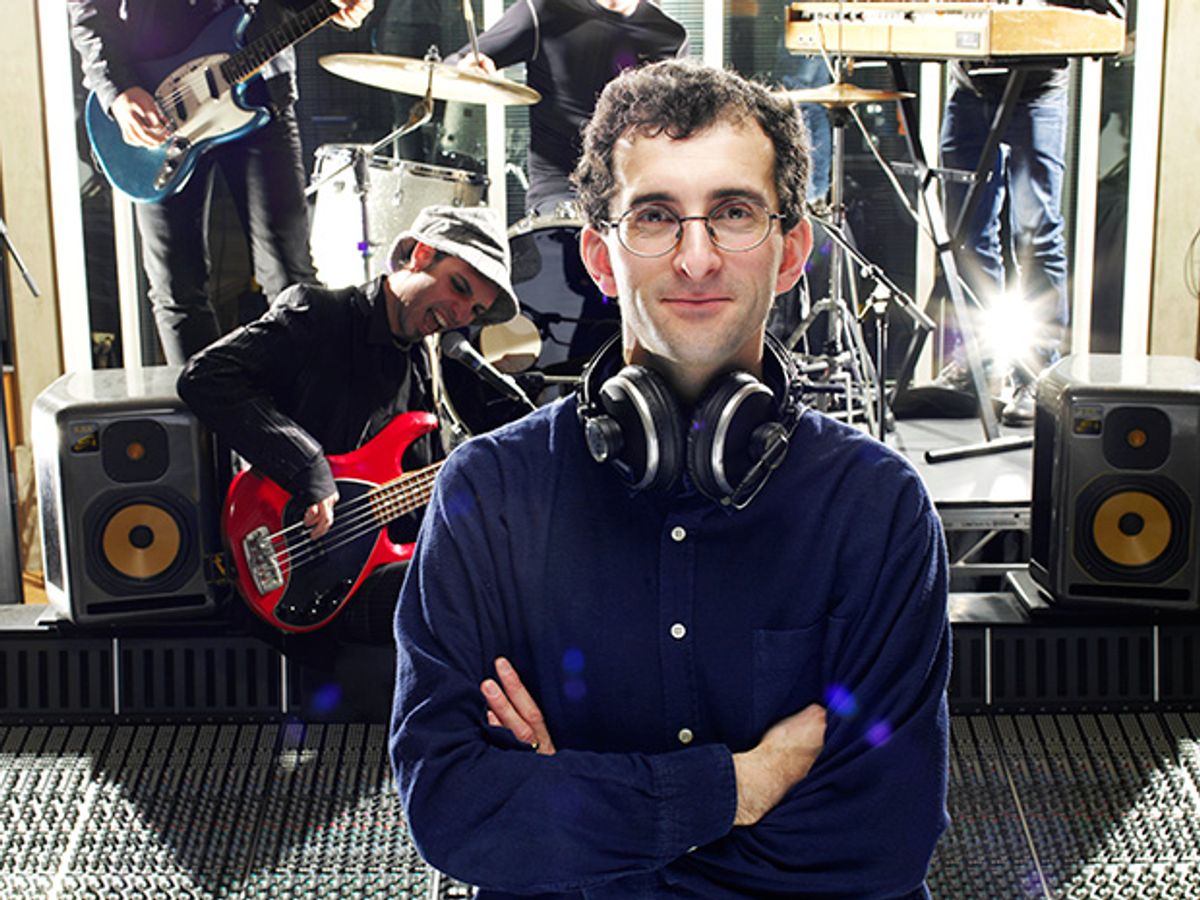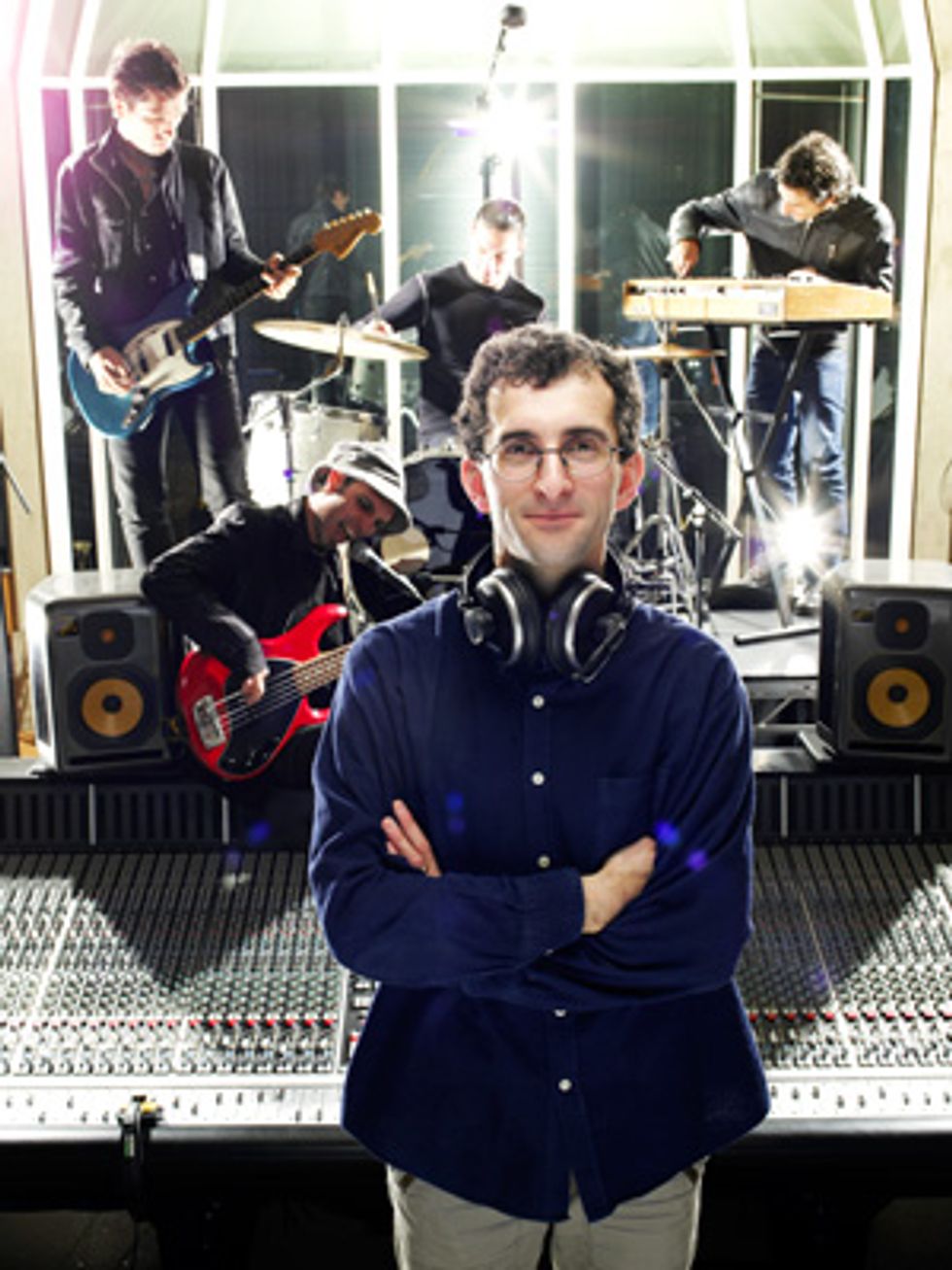Marco Migliari: Studio Virtuoso
At Real World Studios in the British countryside, he masters the mix

Marco Migliari steps into the vast recording studio and shuts a heavy metal door behind him. Silence fills the cavernous space where Peter Gabriel, Van Morrison, Coldplay, and Robert Plant have all taken their turns behind the microphone. “I like this sort of steadiness, the quietness of the studio,” Migliari says. “It’s kind of waiting for something to happen.”
And a lot does happen here at Real World Studios, a recording facility founded by Gabriel and best known for its vibrantly eclectic world-music productions. Tucked amid farms and stone houses in the village of Box, a 2-hour drive west of London, it’s regarded as one of the most high-tech and innovative places for making music. Migliari has worked here as a sound engineer for 12 years. In that time, he’s kept pace with a sea change in recording technology, as digital systems and software have gradually supplanted vacuum tubes and analog electronics. And he’s worked with top recording artists from all over the world. It’s Migliari’s job to make them sound good.
His introduction to audio technology came in the early 1980s, when he was still a schoolboy in Osimo, a small town in central eastern Italy. Hanging out at a local radio station, he learned to patch cables, work the reel-to-reel recorder, and sequence music in cassettes. That experience eventually led him to enroll in electronic engineering at Università Politecnica delle Marche, in nearby Ancona, in 1988.
He found the courses dull but didn’t give up. On the side, he worked as a freelance sound technician, setting up sound systems for theater and dance performances and “lots of scruffy rock bands,” he recalls. Five years later, he was still struggling in engineering school and beginning to tire of the sound gigs. At the age of 24, Migliari had a “bit of an existential crisis.”
That summer, in 1993, while operating the sound system at an academic conference, he got to talking with a sound engineer from Rome. He told Migliari about a two-year music-technology course at Newcastle College in England. “That was a major turning point,” Migliari says. “I realized I could just get out and start again.”
He wrote to Newcastle—“with the really terrible English I had at the time”—and the college asked him to come for an interview. The interview went well, and he was accepted. He still remembers touring the school’s facilities and feeling like he’d landed “in a gold mine.” Life in northeast England, though, took some getting used to. “It was bloody cold,” he says. “I had, like, three flus in a month, one after the other.”
At Newcastle Migliari learned about technologies like MIDI (musical instrument digital interface), recording and mixing techniques, and all aspects of record production. As part of the program, he got an internship at Real World. The work wasn’t glamorous; he spent most of his time hauling gear, fixing equipment, and stringing cables. But his boss let him fiddle around in the studios that weren’t in use. “I’d stay up until 4 o’clock in the morning studying the console, trying things out,” he says.
One day, a manager asked him to help out on a studio session. “I said, ‘Yeah! No problem!’ ” Migliari says. The session turned out to be with Peter Gabriel himself and members of his former band, Genesis, who were remixing some archival material. Working with such famous musicians was a surreal experience, Migliari says, but he kept a low profile: “You watch, you learn.”
After he graduated in 1996, Real World offered him a job. It was a great opportunity, but he’d been planning to return to Italy, and he wrestled with the decision. Then Barbara, his girlfriend back home, agreed to join him in England. He took the job, they got married soon after, and he’s been a fixture at Real World ever since. The tales he collected—all-nighters hunkering down in the studio, flames coming out of a mixing console, raucous fights among musicians—are “too many to remember, and some I cannot tell,” he says with a grin.
On a pitch-black November night, Migliari pokes around the biggest of Real World’s seven studios. Dubbed the Big Room, it’s a 200-square-meter, high-ceilinged, acoustically sealed chamber where musicians and sound engineers square off in the same space. In conventional studios, he says, artists and engineers sit in different rooms, separated by a glass window. “Peter [Gabriel] wanted to get everyone to be part of the creative process,” Migliari says. “It works just great.”
The idea is to make artists feel comfortable, at ease, so they can play their best. “I believe that music cannot exist without performance,” Migliari says, “and that’s something that often gets lost in a studio.” Hence the Big Room’s comfy couches and windows with vistas of a millpond. “It’s a recording studio—and also a lounge with a great view,” he says.

The room itself is a technological marvel. The floor hides kilometers of cables for hooking up instruments, and a closet houses racks of computers and data-storage systems. Dominating one side of the room is a custom XL9080K mixing console, made by Solid State Logic, which is based in Oxford. The console has hundreds of input and output ports and some 2000 control buttons. “The technology choices here I haven’t seen in any other studio,” Migliari says.
Some six decades ago, he explains, a singer like Frank Sinatra would have had his vocals recorded right along with the accompanying orchestra. It was essentially a live performance captured on tape. The Beatles helped advance multitrack recordings, often using four separate tracks for vocals and instruments that could be mixed later. Now a console like the Big Room’s XL9080K can record 144 separate channels.
During a session, he determines how to position the performers and how best to capture their voices and instruments. It’s a task that’s more complex than it appears, requiring an encyclopedic knowledge of such esoterica as the characteristics of different sound-baffling materials and the capabilities of advanced audio compressors. Indeed, flash a microphone in front of him, and he’ll tell you, “Neumann TLM 49 large-diaphragm transistor mic—good for vocals, piano, and strings.”
Often musicians show up with exotic instruments, some of which he’s never seen before and a few that don’t even have names, because the performers built them themselves. “You just walk around the thing, and you think, where does it sound best to my ears?” he says. “And then you put a microphone where your ears are.”
After setting up all the equipment, he decides what sampling rates, encoding schemes, and storage formats to use. As the session progresses, he tweaks the audio signals, adjusting gain, volume, equalization, and dynamic range. In that way, he helps transform electric current into beautiful music.
When Migliari is not in a studio recording or at home chasing after his kids, ages 7, 4, and 1, he’s writing articles for magazines like Future Music , helping organize sound-engineering courses at the Università degli Studi di Firenze and at Real World, and meeting up with musicians in the United Kingdom and abroad. He recently began working as a freelance sound engineer, mixer, and producer, working with a London-based experimental rock band called the Moonfish, an Italian songwriter and singer, and a 15-piece ensemble of drummers from Zimbabwe. “They’re all very different, and they’re all very good,” he says. “You never stop learning.”
He’s amazed at how much audio technology has evolved since his days at Newcastle. “I learned the trade with analog gear that took two people to carry,” he says, but he’s eagerly embraced digital audio systems and software like Digidesign’s Pro Tools, which works just like a real mixing console and is gaining popularity in the music industry.
But technology can’t replace everything, he notes. No piece of programmed or computer-generated music will ever equal the sound that comes from musicians sitting in a studio like the Big Room. “You cannot fake a performance,” he says. “There’s no computer that can do that for you. There’s got to be someone to make it real.”